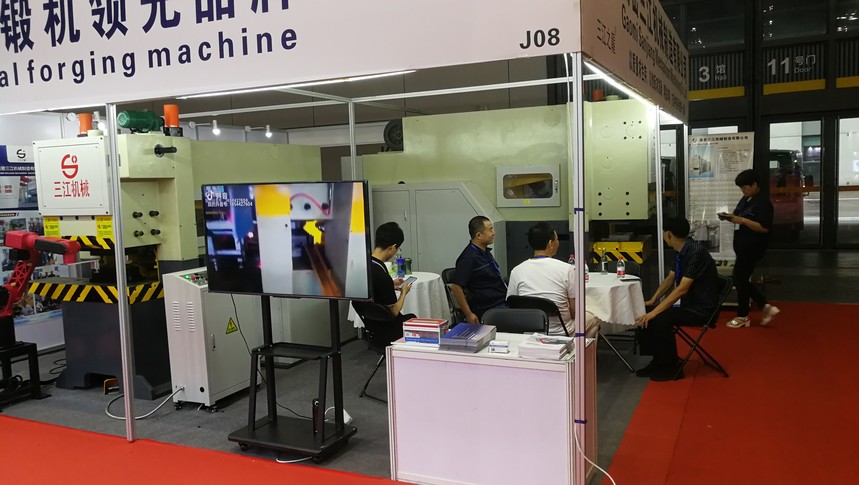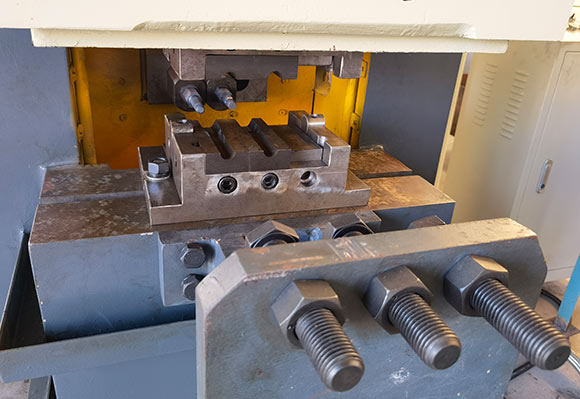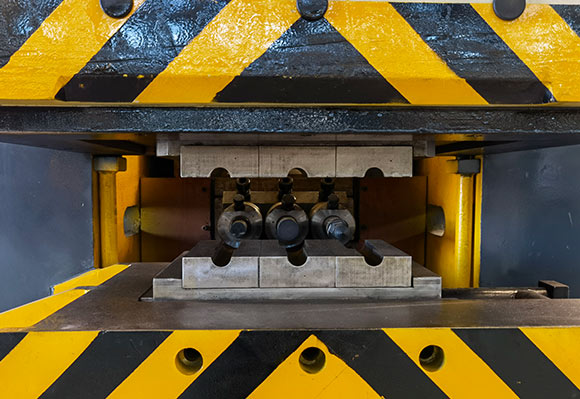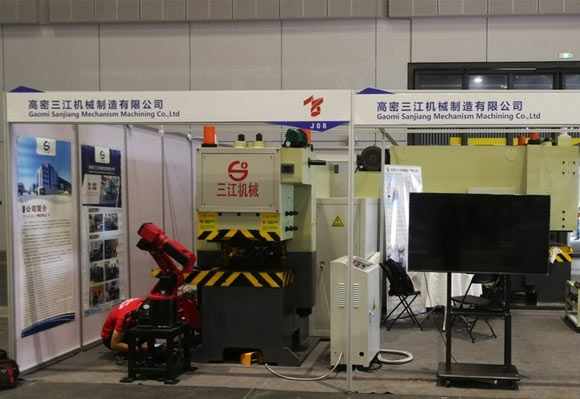The flat forging machine manufacturer introduces the types of die forging to you
Under the action of external force, the metal blank is plastically deformed in the die and filled with the die bore (die cavity) to obtain the forging with the required shape and size. Most metals are die forged in the hot state, so die forging is also called hot die forging. Compared with free forging, die forging can forge forgings with more complex shape and accurate size, with high production efficiency. It can mass produce forgings with basically the same shape and size, which is convenient for the subsequent cutting process to adopt automatic machine tools and automatic production lines. After die forging, a directional fiber structure, namely streamline, is formed in the forging. Selecting reasonable die forging process and die to make the distribution of streamline consistent with the shape of parts can significantly improve the mechanical properties of forgings. However, die forging needs a special die, which should be made of excellent alloy tool steel. The shape of the die chamber is complex, requires high precision, large processing capacity, long production cycle and high price. Therefore, die forging is generally suitable for mass production, or for occasions with small batch but high requirements for the shape and performance of forgings. Flat forging machine
Die forgings have high precision and small machining allowance. The determination of machining allowance needs to consider the manufacturing accuracy of die and its wear in use, cold shrinkage and surface oxidation of metal, metal flow and filling state, slope required for forging, fillet and forging deviation, and allowance required for cutting. In actual production, the machining allowance of forgings is selected according to the standard. Using special precision forging process, strictly controlling the local tolerance of forgings, leaving no machining allowance and no cutting, is one of the development directions of modern die forging technology.
Die forging is usually divided into hammer die forging, hot die forging, press die forging, screw press die forging, hydraulic press die forging, flat forging machine die forging and electric upsetting according to the equipment used.
Hammer die forging is widely used in production. The forging die is divided into upper and lower parts, which are respectively fixed on the hammer head and anvil of the die forging hammer. The forging is formed by the upper die on the hammer head hitting the lower die on the anvil (the die forging hammer without anvil is hit by the upper and lower anvils). The blank often goes through several blank making processes. Therefore, a corresponding plurality of die bores are set on the forging die. During forging, the blank shall be heated to the initial forging temperature (see forging blank heating), and then the forging blank shall be manually moved into the corresponding die chamber according to the process, hit successively by the forging hammer, and formed in the final forging die chamber. Typical hammer forging goes through six processes ① upsetting: it is used to reduce the blank height and increase the cross-sectional area. ② Lengthening: turn the blank around the axis and feed it along the axis to reduce the local section of the blank and prolong the length of the blank. ③ Rolling: only turning over without feeding during operation can enlarge the local section aggregation of the blank and make the appearance of the whole blank round and smooth. ④ Bending: used to change the shape of blank axis. ⑤ Pre forging: improve the forming conditions of forgings and reduce the wear of final forging die bore. ⑥ Final forging: forming the forging to determine the shape and accuracy of the forging. Flash grooves are opened around the final forging die bore. Flat forging machine
The die forging hammer has fast strike speed and large impact energy, and the strike weight can be controlled by the operator at will. Therefore, it has good adaptability to forgings. It can forge forgings of various complex shapes from less than 1kg to about 200kg, such as engine connecting rod, crankshaft, automobile universal joint, front beam and various gears. Hammer forging has high productivity and less equipment investment. The disadvantages are high vibration and noise, difficult to master operation technology, poor working conditions and high labor intensity. In addition, the die forging hammer generally has no ejection device, the forging requires a large die forging inclination, and the service life of the die is low.
Hot die forging press die forging hot die forging press is generally a crank mechanical press. Its vibration and noise are smaller than that of hammer die forging, the operation technology is easy to master, the productivity is high, and it is convenient to use manipulator to realize automatic production. Flat forging machine
The hot die forging press has good rigidity, high sliding block guiding accuracy, and a forging ejection device, which can use a small die forging inclination. The stroke of hot die forging press is fixed. It can not replace roll forging machine or other equipment to complete the corresponding blank making operation, nor can it use impact inertia to form forgings like forging hammer. In order to make the forging full of the die bore, it is often necessary to increase the number of pre forging to make the blank gradually approach the forging shape in several die bores, so the structure of the die is more complex. Hot die forging press is suitable for mass production.
Screw press die forging screw press is characterized by large impact inertia of forging hammer, good guidance of mechanical press, ejection device and no steam power. It is a relatively easy-to-use die forging equipment. It only produces a small amount of flash, and the die angle is very small. After forging, the forging is pushed out by the ejector rod. For small and medium-sized forgings, the single die chamber forging effect is very good, especially for upsetting the head of valve, bolt and other rod parts. The forging with complex shape can be preformed on other equipment, and then finally forged on the screw press.
Hydraulic press die forging hydraulic press has the advantages of low working speed, large stroke, high pressure, adjustable and ejection device; If necessary, pressure can also be applied from several directions (multi-directional die forging hydraulic press). The pressure of the giant hydraulic press reaches tens of thousands of kn, and the working platform area reaches tens of square meters. It is suitable for die forging large steel, titanium alloy, aluminum alloy and magnesium alloy forgings, especially large aviation forgings, such as aircraft frame and landing gear girder. Multidirectional die forging hydraulic press is suitable for forging various complex forgings with multiple empty cavities, such as high-pressure casing, valve body, trigeminal and Quad pipe joints, etc.
Die forging of flat forging machine, also known as flat forging, is a common method of upsetting the head of long rod and pipe fittings and manufacturing ring parts with through holes with bar materials, such as manufacturing the flange part of long shaft, bearing ring, etc. During operation, the movable die moves to clamp the heated bar at the end, and then upsetting is carried out by the multi station punch fixed on the main sliding block to make the metal fill the die bore of the die. If the length of the deformed part of the bar is greater than 3 times of the bar diameter, the bar end must be accumulated once or several times before pre forging and final forging to avoid bending or folding of the bar during upsetting. When forging the through hole, the forging with blind hole shall be forged first, and then the forging shall be separated from the bar when the punch is perforated. Flat forging machine
Generally, flat forgings do not produce flash or only produce small flash, so the utilization rate of materials is high, but the bar material needs to be clamped and forged, so the bar material is required to have a small diameter tolerance.
The die forging process of electric upsetting applies pressure while heating the end of the bar to make it upset and deform. One end of the bar is energized, and the resistance of the bar itself is used for contact heating. At the same time, axial pressure is applied to the end of the bar to gradually heat and thicken one end until the die chamber is filled and formed. This method combines heating and deformation on one machine at the same time, so it has good forming and high efficiency. It is mainly used for the forming of internal combustion engine valves. Flat forging machine
With the progress of technology, in addition to the continuous improvement of traditional die forging methods, there are also many new precision and high-speed die forging processes and equipment. For example, when the turbine blade is precision forged with a hydraulic screw press, only a small amount of grinding allowance is left on the blade surface; Precision die forging gear, tooth profile can no longer be machined; Multi station automatic hot heading machine forms long bar or disc bar, which is fed, heated, cut into fixed length blank, and then formed in 3 ~ 4 stations. The whole process is carried out automatically, and 40 ~ 70 gear blanks and bearing ring blanks of about 3kg can be forged every minute. High speed hammer forging is die forging with special equipment. Extrusion and cold heading, in a broad sense, also belong to die forging and hot stamping, which generally refers to punching, blanking and bending of thicker materials than material processing; Hot upsetting extrusion refers to extrusion type, such as tools, wrenches, screw caps and nuts.





